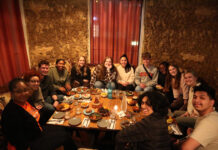
When Dr. Clara Mengolini came to Mercer University in 2015, she had the opportunity to teach a class in Great Books or Integrative Curriculum, commonly called INT.
“I went directly to Great Books because I couldn’t understand what was INT,” she said.
Dr. Mengolini, an associate professor of Spanish, now has been teaching INT for five years and loves it. Her experience prompted her to reach out to Dr. Andy Digh, associate professor of computer science, about creating a magazine about the program to explain it to new faculty and students.
This summer they published the first issue of What Is INT?, which showcases INT classes and students’ work. Ashley Curtis, a senior majoring in graphic design, designed the magazine.

“Now we have this magazine, and they can flip through it and see the three-course sequence so clearly,” Dr. Digh said. “It’s just a beautiful way of advertising something that we’re really doing uniquely in the liberal arts here at Mercer.”
The INT series consists of three courses:
- INT 101 prompts students to better understand the relationships between self and others.
- INT 201 explores how to build communities of all kinds.
- INT 301 takes on the challenges of living in an interconnected, global world.
“The main objective is to help students write well, begin to speak well, and really, more than anything else, especially as freshmen, learn to be better critical thinkers,” said Dr. Digh, who has been with the INT program since it started in 2012.
Students often ask why they have to take INT, said Dr. Janell Johnson, the program’s director.
“It’s the foundational liberal arts curriculum here, along with Great Books,” she said. “If our students can look at this magazine and get some sense of the breadth of what we’re trying to do, that would be amazing.”
Within INT’s broad course topics, faculty have the freedom to customize their classes to their own talents and backgrounds.

“For example, I’m a computer scientist. My INT 101 section is about what it means to be human, and I’m able to bring in a little of artificial intelligence and talk about how we’re slowly evolving,” Dr. Digh said. “We already talked about how machines can now do art. Machines can now write. Those are tasks just a few years ago that they never did.
“Students begin to really see this is a course about connecting their knowledge in all the different disciplines.”
In the spring, students in Dr. Mengolini’s INT 301 class on engaging the world analyzed children’s picture books. Students read about 50 picture books from around the world and examined a few comics, graphic novels, cartoons and films.
“Once students are in the class, they realize that the picture books they read talk about immigration, dictatorships and indoctrination and have so many different deep meanings,” Dr. Mengolini said. “They change completely by the end of the semester, and they say, ‘I never thought about children’s literature this way.’”
At the end of the semester, students wrote, illustrated and designed a children’s picture book.
Dr. Johnson recently shared the magazine with faculty members at an INT workshop.
“Faculty were really excited to see what other people were doing in their classes,” she said. “We can all grow from that.”









